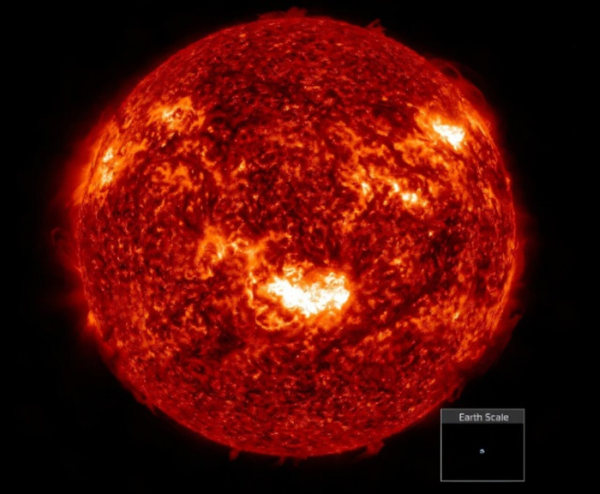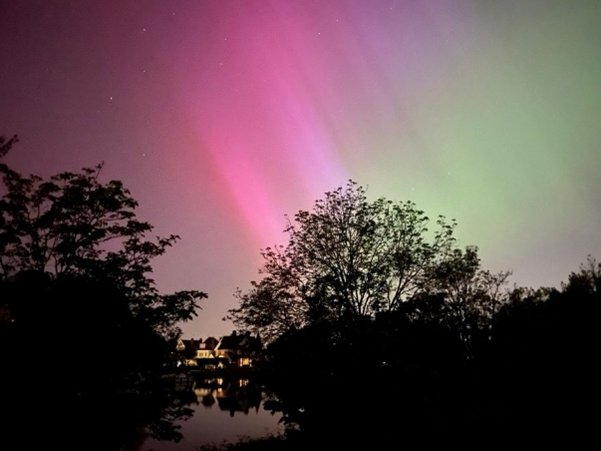The Stunning Auroras in May 2024
The Stunning Auroras in May 2024
CHAN Yuk-hing Joanne, CHAN Ying-lam Venus
September 2025
In May 2024, there were surging reports of stunning aurora photographs on social media, with aurora reports from over 55 countries across all seven continents, including areas far from the poles and at lower latitudes, such as northern China, Korea, Japan and Florida in the United States. Why did widespread auroras occur?
What happened on Sun?
In early May 2024, scientists observed an area on the Sun’s surface composed of highly active sunspots, accompanied with eruptions of solar flares. The National Center for Space Weather and the National Aeronautics and Space Administration (NASA) both indicated that the solar flares were the most intense “X” flares. From the image taken by NASA, it was estimated that the size of this active region was approximately 17 times of the Earth (Figure 1). The occurrence of solar flares was also accompanied by several coronal mass ejections (CMEs), with the coronal materials (including the energetic charged particles) moving rapidly towards the Earth.

Figure 1 An image of the Sun taken on May 7, 2024. The central area of the photo showed occurrence of multiple solar flare eruptions, while the relative size of Earth was shown in the lower right corner. (Image source: NASA)
What happened on Earth?
Highly active solar activities ultimately caused the Earth to experience the strongest geomagnetic storm in over twenty years from 10th May in 2024, and the event was classified as the highest level of “G5” by the U.S. Space Weather Prediction Center (SWPC). This geomagnetic storm affected global positioning system signals, disrupting communication devices in many areas.
Generally speaking, when the energetic charged particles emitted by the Sun enter the Earth’s atmosphere, they are directed towards the magnetic poles by the Earth's magnetic field. As the Earth’s magnetic poles are close to the geographic poles, auroras are typically seen in high-altitude regions. However, the intense solar activity this time caused massive influx of energetic charged particles entering the Earth, resulting in significant distortion of the Earth's magnetic field. As a result, auroras could be seen in some lower latitude regions with much more widespread coverage than usual. In addition, magenta auroras were observed in many regions, instead of red auroras which were much more common. Through studying hundreds of photos, researches revealed that the auroras were in a very high altitude of approximately 900 km above the ground, instead of altitude of 600 km that red auroras typically appear. Scientists believed that the geomagnetic storm caused the Earth’s thermosphere to reach over 1,100°C and expand. The resulting magenta aurora was the combination of red and blue auroras, caused by simultaneous excitation of nitrogen and oxygen molecules.

Figure 2 Aurora photo taken at London, UK in May 2024. (Image source: MC Chow)
Conclusion
The most intense solar storm on record so far was 1859 Carrington Event. This Event caused telegraph stations in Paris and Washington to spark, leading to shutdown of most communication channels. Although the geomagnetic storm in May 2024 did not result in comparable impacts to that of the Carrington Event, and even let us appreciate the stunning auroras, it reminds us to be vigilant of the potential effects of extreme geomagnetic storms on Earth.
References:
[1] 我國發佈太陽耀斑預警 ,會影響正常生活嗎? 中國氣象局。
[2] Five historically huge solar events, National Oceanic and Atmospheric Administration (NOAA), 14 April 2025.
[3] The biggest geomagnetic storm in 20 years: NASA's lessons and surprises, by Mara Johnson-Groh, NASA's Goddard Space Flight Center, 10 May 2025.
[4] There’s a Violent Solar Storm That Could Have Been Worse—Here’s the Scary Truth, NASA SPACE NEWS, 11 May 2025.
[5] The Gannon Storm: citizen science observations during the geomagnetic superstorm of 10 May 2024, Maxime Grandin, et. Al. (2024), https://doi.org/10.5194/gc-7-297-2024.
[6] Extended magenta aurora as revealed by citizen science. Kataoka, R., Reddy, S.A., Nakano, S. et al. Sci Rep 14, 25849 (2024). https://doi.org/10.1038/s41598-024-75184-9.
[1] 我國發佈太陽耀斑預警 ,會影響正常生活嗎? 中國氣象局。
[2] Five historically huge solar events, National Oceanic and Atmospheric Administration (NOAA), 14 April 2025.
[3] The biggest geomagnetic storm in 20 years: NASA's lessons and surprises, by Mara Johnson-Groh, NASA's Goddard Space Flight Center, 10 May 2025.
[4] There’s a Violent Solar Storm That Could Have Been Worse—Here’s the Scary Truth, NASA SPACE NEWS, 11 May 2025.
[5] The Gannon Storm: citizen science observations during the geomagnetic superstorm of 10 May 2024, Maxime Grandin, et. Al. (2024), https://doi.org/10.5194/gc-7-297-2024.
[6] Extended magenta aurora as revealed by citizen science. Kataoka, R., Reddy, S.A., Nakano, S. et al. Sci Rep 14, 25849 (2024). https://doi.org/10.1038/s41598-024-75184-9.